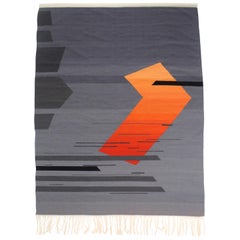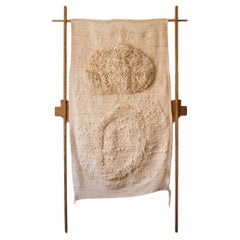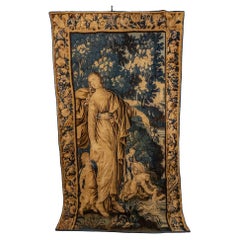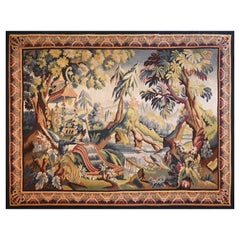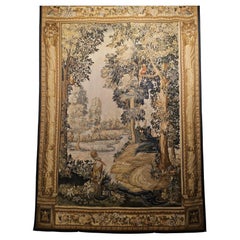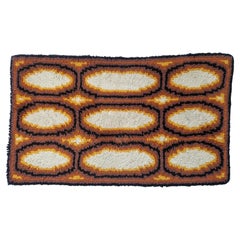Wool Tapestries
to
270
1,392
1,364
2,140
613
116
Height
to
Width
to
373
195
84
81
80
33
31
14
10
9
8
8
8
7
6
4
3
564
421
1,155
729
167
643
270
35
4
31
17
31
76
97
118
38
6
4,228
2,869
995
911
229
1,522
1,005
832
414
305
2,869
2,407
2,536
111
51
30
25
23
Material: Wool
Contemporary Handwoven Wool Rug Red and Grey Toned Kilim or Tapestry
By Andrew Boos
Located in Brooklyn, NY
Inspired by the physics of light. The shifting tones and negative space echo the spectrum of light emitted from an object as it moves away from us in space.
The asymmetrical design...
Category
21st Century and Contemporary American Modern Wool Tapestries
Materials
Wool, Cotton
Artwork Tapestry Made of handspun and handwoven local Wool
Located in Marseille, FR
- Hand-spun and hand-woven wool tapestry
- 2020
Dimensions:
250 H x 145 W CM
98.4 H x 57 W IN
MADE IN COLLABORATION WITH ODU WORKS
EDITION OF 3 + 1 ARTIST’S PROOF
WOOD FRAME BY EL...
Category
2010s Moroccan Wool Tapestries
Materials
Wool
17th Century Flemish Aubusson Tapestry
Located in Houston, TX
The 17th Century Flemish Aubusson Tapestry portraying a woman traveling or walking with her child is a captivating depiction of everyday life...
Category
17th Century Belgian Baroque Antique Wool Tapestries
Materials
Wool, Silk
Aubusson Tapestry from 19th Century - N° 1240
Located in Paris, FR
a very prettyAubusson tapestry of 19th century with red and blue and white colors, a temple and rivers in very good condition- N° 1240
Thanks to our Restoration-Conservation works...
Category
1880s French Aubusson Antique Wool Tapestries
Materials
Wool
Vintage Hand-Woven French Aubusson Tapestry of Forest Scene with Birds in Trees
Located in Barrington, IL
A beautifully hand-woven French Aubusson tapestry in the style of 17th-century Verdure tapestries, created in 20th-century France. This timeless work of textile art features a serene nature scene, with birds perched on tree branches amidst a lush, tranquil forest.
Woven in classic Verdure style, the tapestry showcases an exquisite palette of soft greens and blues, capturing the depth and serenity of the woodland landscape. The tapestry is backed with cloth and includes a sewn-in pocket for a display rod, making it ready for elegant hanging.
A stunning decorative piece that evokes the romantic charm and masterful craftsmanship of historic French weaving.
Dimensions: 6’ x 8’
Date of Manufacture: Late 1900s
Place of Origin: France
Material: Wool
Condition: Good
The Persian Knot Gallery, SKU 1974
Vintage Handwoven Tapestries, French Aubusson Tapestry, Aubusson Tapestry Pillows, European Embroidery,18th Century Antique French Tapestry, Large Wall Tapestry, Handwoven Tapestry, Modernist Tapestry, Mid Century Wall Tapestry, Antique Tapestry with Frame...
Category
Late 20th Century French Aubusson Wool Tapestries
Materials
Wool
Rare Midcentury Small Rug / Carpet or Wall Tapestry Ege Rya, Denmark, 1970s
By Ege Rya
Located in Praha, CZ
- very rare type
Category
1970s Danish Mid-Century Modern Vintage Wool Tapestries
Materials
Fabric, Wool
Space age hand knotted wall hanging, Germany 1970
By Desso
Located in ECHT, NL
Magnificent space age wall tapestry. Handcrafted in the 1970s. It has an abstract decor. The patterns have different heights.
The tapestry is in very good condition. It looks almost...
Category
Mid-20th Century German Space Age Wool Tapestries
Materials
Wool
Antique 16th Century Brussels Baroque Mythological Tapestry with Angel
Located in New York, NY
Tapestries were ubiquitous in the castles and churches of the late medieval and Renaissance eras. At a practical level, they provided a form of insulation and decoration that could b...
Category
16th Century Belgian Baroque Antique Wool Tapestries
Materials
Tapestry, Wool
French Tapestry Around 1950 Framed, N° 1169
Located in Paris, FR
French tapestry around 1950 framed - n° 1169
the tapestry is framed and ready to hang on the wall
Thanks to our Restoration-Conservation workshop and also Our know-how,
we are pl...
Category
1950s French Aubusson Vintage Wool Tapestries
Materials
Wool
Horizon Marine Tapestry by Jean Picart Le Doux, Signed, Great Condition
Located in Kansas City, MO
Large Jean Picart Le Doux "Horizon Marin" tapestry handwoven at Atelier Pinton in Aubusson France. Signed. Limited edition. Virtually no signs of wear. ...
Category
1960s French Mid-Century Modern Vintage Wool Tapestries
Materials
Wool
Late 19th Century English William Morris Large Leaf Verdure Tapestry
Located in New York, NY
An English William Morris verdure tapestry from the turn of the 20th century, featuring several peacocks within a verdant setting of large leaves and floral sprays. Enclosed within a...
Category
Early 20th Century English Art Deco Wool Tapestries
Materials
Wool
$10,995 Sale Price
31% Off
Orange Fish, Elie Grekoff - French Tapestry By Atelier Pintons Frers - No. 1469
Located in Paris, FR
Artist: Elie Grekoff
Period: 20th century
Style: Design 50's and 60's
Condition: Perfect condition
Material: Wool
Width: 242 cm
Height: 148 cm
Depth: 0.5 cm
Marine theme: The centra...
Category
20th Century French Aubusson Wool Tapestries
Materials
Wool
French Signed Aubusson Tapestry, Hide-and-Seek Game Scene - 204X187cm - No. 1540
Located in Paris, FR
Period: 19th century
Condition: Perfect condition
Material: Wool & Silk
Width: 204 cm
Height: 187 cm
Depth: 1 cm
In keeping with tradition, this magnificent tapestry has undergone a...
Category
19th Century French French Provincial Antique Wool Tapestries
Materials
Wool, Silk
Vintage Hand Woven Folkloric Tapestry in Marc Chagall-Inspired Design
Located in Barrington, IL
This stunning vintage mid-century tapestry depicts a folkloric rider performing acrobatics atop a galloping horse. Woven in jewel-toned colors, the piece radiates rhythm, motion, and...
Category
Mid-20th Century Baltic Wool Tapestries
Materials
Wool, Cotton
15th Century Antique Brussels Millefleur Tapestry 6' X 5'
Located in Los Angeles, US
A wall hanging tapestry, simply put, is a textile specifically designed and woven to portray an artistic scene with the intent of hanging it on a wall. Antique tapestries, those that...
Category
15th Century and Earlier Unknown Other Antique Wool Tapestries
Materials
Wool, Cotton
Abstract Vibrant Wall Tapestry by Junghans, 1960's
Located in London, GB
Colorful hand knotted wool hanging is probably a translation of the work of an artist. This was a time when modern artists work began to work with weavers...
Category
1960s German Mid-Century Modern Vintage Wool Tapestries
Materials
Wool
Pierre Adrien Chabal, Louis XVI Style Beauvais Tapestry Panel, France, C.1855
Located in Chatham, ON
PIERRE ADRIEN CHABAL-DUSSURGEY (1819-1902) Designer - BEAUVAIS TAPESTRY MANUFACTORY Maker - Important Antique Louis XVI style floral tapestry chair back - the floral tapestry finely woven in wool and silk threads with garlands and swags and tassels - all centered by a powder blue ground cartouche with white roses within an oval frame - suitable for framing - France - circa 1855.
Excellent antique condition - minor fading and loss - areas of wear/thinning - no apparent restoration - minor stains and soiling with signs of age and use.
Size/Dimensions - 20" (51 cm.) Wide x 19 1/2" (49.5 cm.) High.
PIERRE ADRIEN CHABAL-DUSSURGEY - born Pierre Adrien Chabal in 1819 in Charlieu and adopting the professional name of CHABAL-DUSSURGEY - well known for his paintings and studies of flowers in gouache and oils - attended the School of Fine Arts in Lyon - exhibited at the Paris and Lyon salons - he worked with the Gobelins Tapestry Manufactory and the Beauvais Tapestry Manufactory after 1849 designing tapestries, rugs and tapestry covers for seating - he designed tapestries for the Élysée Palace and worked with Empress Eugenie on furnishings for the small salon at the Élysée Palace and two salons in the palace of the Empress in Biarritz - tapestry covered furniture...
Category
Mid-19th Century French Louis XVI Antique Wool Tapestries
Materials
Wool, Silk
Late 16th Century Brussels Historical Tapestry with the Roman General Scipio
Located in New York, NY
A Brussels historical tapestry, attributed to Martin Reymbouts, late 16th century. From the story of Scipio series, the renowned Roman general, a royal c...
Category
16th Century Belgian Antique Wool Tapestries
Materials
Wool
$199,995 Sale Price
33% Off
17th Century Fine Flemish Tapestry, Silk & Wool, Green, Blue, Red, Battle Scene
Located in Port Washington, NY
The tapestry shown here is a magnificent example of 17th-century European artistry, likely influenced by the grand tradition of tapestry weaving that flourished in France and Flander...
Category
Mid-17th Century French French Provincial Antique Wool Tapestries
Materials
Wool, Silk
$79,199 Sale Price
20% Off
1950's Persian Shiraz Pictorial Carpet with Traditional Style
Located in Dallas, TX
79097 Vintage Persian Shiraz Pictorial Rug, 03'10 x 06'04. This extraordinary hand-knotted wool vintage Persian Shiraz rug presents a captivating pictorial narrative, vividly depicti...
Category
Mid-20th Century Persian Aesthetic Movement Wool Tapestries
Materials
Wool
Antique 16th Century Flemish Tapestry 3'1" X 1'3"
Located in Los Angeles, US
A wall hanging tapestry, simply put, is a textile specifically designed and woven to portray an artistic scene with the intent of hanging it on a wall. Antique tapestries, those that...
Category
16th Century Unknown Other Antique Wool Tapestries
Materials
Wool, Cotton
Aubusson French handmade tapestry made of wool and cotton.
Located in Firenze, FI
This 310 cm. x 210 cm. large tapestry originates from Aubusson in France, known for their fine quality and detailed designs
A castle in the background and a hunting scene in the fore...
Category
1950s French Vintage Wool Tapestries
Materials
Wool, Cotton
Bobyrug’s Pretty Vintage Egyptian Tapestry
Located in Saint Ouen, FR
Exquisite midcentury Egyptian tapestry, inspired by the Ramsès Wissa Wassef School Tapestries. Featuring a stunning nature-themed design with animals, birds, and fish, adorned with v...
Category
Mid-20th Century Egyptian Aubusson Wool Tapestries
Materials
Wool, Cotton
1820's Antique French Aubusson Tapestry with Venus and Adonis, 07'00 x 14'06
Located in Dallas, TX
77237 Antique French Aubusson Tapestry with Venus and Adonis, 07'00 x 14'06. This magnificent handwoven wool and silk antique French Aubusson tapestry exudes the grandeur and elegance of the Early 19th Century, drawing inspiration from the works of Italian Baroque painter Francesco Albani...
Category
Early 19th Century French Louis XIV Antique Wool Tapestries
Materials
Wool, Silk
18th Century French Pastoral Landscape Tapestry, with Shepherds and Their Sheep
Located in New York, NY
A French pastoral landscape tapestry from the 18th century, envisioning a placid scene in which a shepherd and shepherdess repose under a large tree with three of their sheep within ...
Category
18th Century French Antique Wool Tapestries
Materials
Wool
$2,995 Sale Price
25% Off
Antique Indian Handmade Paisley Textile Shawl with Brilliant Colors
Located in Atlanta, GA
Antique Indian Handmade Paisley Textile Shawl in Red and Brilliant Border.
19th Century Antique Indian Hand made Paisley Textile Shawl with Brilliant...
Category
Early 1900s Indian Tribal Antique Wool Tapestries
Materials
Wool
Textured macrame wall hanging, Spain, 1970s
Located in BARCELONA, ES
Superb macramé wall tapestry made in Spain in the 1970s. Large format. Handmade tapestry composed of different textures and materials creating unique patterns and reliefs. All the ro...
Category
1970s Spanish Hollywood Regency Vintage Wool Tapestries
Materials
Wool, Cotton
Pretty Vintage Aubusson Style Jacquard Tapestry
Located in Saint Ouen, FR
"Exquisite late 20th-century French tapestry featuring the enchanting design 'VERDURE AU MOULIN' after François Boucher. Capturing nature in its most picturesque form, adorned with p...
Category
Mid-20th Century French Aubusson Wool Tapestries
Materials
Wool, Cotton
Wonderful Vintage French screen printed Tapestry by hand. « Idyll »
Located in Saint Ouen, FR
Idyll (by François Boucher)
Discover the elegance of this mid-century French screen printed tapestry by hand featuring the exquisite design of the renowned French Painter Francois Bo...
Category
Mid-20th Century French Romantic Wool Tapestries
Materials
Wool, Cotton
1930 Royal Manufacture Aubusson Animal Forest Tapestry Silk Wool Red Green
Located in Paris, FR
🌿 What Is a Greenery (Verdure) Tapestry?
A greenery tapestry (French: verdure) typically features:
Lush landscapes with stylized trees, foliage, plants, and flowers
Often includes...
Category
1930s French Aubusson Vintage Wool Tapestries
Materials
Wool, Silk
1970s Block Print Tapestry by Jean Claude Bissery
Located in Denton, TX
Vintage wool tapestry depicting a floral and musical motive. Beautiful flowing lines of green, black and orange. Signature Jean Claude Bissery and ERF
Category
Mid-20th Century French Mid-Century Modern Wool Tapestries
Materials
Wool
nice vintage French Aubusson style Jacquard tapestry “lady and licorn”
Located in Saint Ouen, FR
Nice vintage French Aubusson style tapestry with a design of a 15th century museum tapestry “Dame à la licorne - le goût » (lady with licorn - the taste) and beautiful colours, woven...
Category
Late 20th Century French Aubusson Wool Tapestries
Materials
Wool, Cotton
Wonderful Vintage French Aubusson style Hand Printed Tapestry “ country concert”
Located in Saint Ouen, FR
Concert Champêtre ( country concert )
Very beautiful mid century French Aubusson style tapestry with a beautiful 15th century tapestries design showing a scene in the countryside, ou...
Category
Mid-20th Century French Aubusson Wool Tapestries
Materials
Wool, Cotton
Original Elie Grekoff Tapestry Zodiac Cancer Wool Paris Proof of Authenticity
By Elie Grekoff
Located in Miami, FL
Signed Zodiac Grekoff handwoven tapestry in wool & cotton, titled Cancer.
Marked at the Front right corner and proof of authenticity on the reverse.
Category
1960s French Mid-Century Modern Vintage Wool Tapestries
Materials
Wool, Cotton
Special Piece Ivory Color Antique Flanders Biblical Tapestry life of Moses Rug
Located in New York, NY
17th Century Flanders Biblical Tapestry ( 10' x 12'8" - 305 x 385 )
Subject: Scene from a life of Moses Series, probably the reconciliation of Miriam and Zipporah
Period: Late 16th ...
Category
Early 17th Century Belgian Other Antique Wool Tapestries
Materials
Wool
Bobyrug’s Wonderful Antique French Aubusson Tapestry
Located in Saint Ouen, FR
Very beautiful mid century original French Aubusson tapestry with nice romantic design and beautiful colors, entirely hand woven with wool a...
Category
Mid-20th Century French Aubusson Wool Tapestries
Materials
Wool, Silk
Aubusson Tapestry, Berger Mouton, xix E. Century, N° 1149
Located in Paris, FR
Aubusson tapestry - Berger Mouton - XIX E. century mille fleures gothic.
Thanks to our Restoration-Conservation workshop and also Our know-how,
we are pleased to present to you wo...
Category
1880s French Aubusson Antique Wool Tapestries
Materials
Wool
Vintage Embroidered Picture "Beautiful Rose" in a Golden Frame
Located in Bussiere Dunoise, Nouvel Aquitaine
French Vintage Embroidered Picture "Beautiful Rose" in a Golden Frame from the Mid-Century.
This lovely artwork features a stunning hand-embroidered rose motif in soft colors, set w...
Category
1950s French Folk Art Vintage Wool Tapestries
Materials
Metal
$154 Sale Price
35% Off
Wonderful large antique French Aubusson rug
Located in Saint Ouen, FR
Exquisite large Antique French Aubusson rug from the early 20th century, meticulously handwoven in wool on Aubusson looms. Featuring a Louis XVI-style floral design in lovely light h...
Category
Early 20th Century French Aubusson Wool Tapestries
Materials
Wool, Cotton
Vintage Persian Shiraz Pictorial Rug, Wall Hanging, Persian Tapestry
Located in Dallas, TX
75045 Vintage Persian Shiraz Pictorial Rug, 03’08 x 05’02. Persian Shiraz pictorial rugs are a distinctive type of Persian rug crafted in the region surrounding the city of Shiraz in...
Category
Late 20th Century Persian Modern Wool Tapestries
Materials
Wool
Vintage Tapestry Depicting Royalty 5X4.10
Located in Los Angeles, US
A wall hanging tapestry, simply put, is a textile specifically designed and woven to portray an artistic scene with the intent of hanging it on a wall. Antique tapestries, those that...
Category
Early 2000s Unknown Empire Wool Tapestries
Materials
Wool, Cotton
Little Vintage Baluch Afghan Rug
Located in Saint Ouen, FR
Nice tribal Baluch Afghan rug with geometrical design and nice colors, entirely hand knotted with wool velvet on wool foundation.
Category
Mid-20th Century Afghan Tribal Wool Tapestries
Materials
Wool
17th Century Antique French Beauvais Grotesque Tapestry
Located in New York, NY
17th century French grotesque tapestry
An antique French Beauvais tapestry from the 17th century, depicting a Grotesque scene with an Elephant and ...
Category
17th Century French Antique Wool Tapestries
Materials
Wool
$240,000 Sale Price
20% Off
Pretty vintage French jacquard tapestry Aubusson style
Located in Saint Ouen, FR
Pretty vintage Aubusson style french tapestry with beautiful floral design and nice colours, woven on the jacquard looms at the Jules Pansu workshops
✨✨✨
"Experience the epitome of...
Category
Late 20th Century French Aubusson Wool Tapestries
Materials
Wool, Cotton
Late 16th Century Brussels Historical Tapestry, with Famed Roman General Scipio
Located in New York, NY
A Brussels historical tapestry, attributed to Martin Reymbouts, late 16th century. From the Story of Scipio series, the renowned Roman general, victorious after the Punic War, with k...
Category
16th Century Belgian Antique Wool Tapestries
Materials
Wool
$149,995 Sale Price
25% Off
Signed Vintage Jean Picart Le Doux Tapestry with Tree Pictorial
Located in grand Lancy, CH
Signed Vintage Jean Picart Le Doux Tapestry with Tree Pictorial
Category
1970s French Vintage Wool Tapestries
Materials
Wool
Antique 18th Century Brussels Mythological Tapestry, with Diana the Huntress
Located in New York, NY
An 18th century Brussels mythological hunting tapestry, size 9' H x 8' W, depicting the Roman goddess of the hunt, Diana, reposing in a forest setting with her attendants, with one h...
Category
Mid-18th Century Belgian Antique Wool Tapestries
Materials
Wool, Silk
$44,995 Sale Price
33% Off
Bobyrug’s Pretty Vintage Mécanique Jaquar Tapestry
Located in Saint Ouen, FR
Very beautiful mid-century French Aubusson style tapestry with nice design and beautiful colors, mechanical Jaquar manufacturing with wool and cotton.
✨✨✨
"Experience the epitome of...
Category
Mid-20th Century French Aubusson Wool Tapestries
Materials
Wool, Cotton
Rene Fumeron Aubusson Tapestry
By Rene Fumeron
Located in New York, NY
Mid-Century tapestry designed by Rene Fumeron (1921-2003) and woven at Atelier Pinton Freres in Aubusson, France. Woven in wool, it dates to 1964 and entitled "Comme La Lune". The a...
Category
Mid-20th Century French Mid-Century Modern Wool Tapestries
Materials
Wool, Tapestry
17th century Antique Flemish Tapestry Wool & Silk Verdure Art Nouveau 4x6ft
Located in New York, NY
17th century Antique Flemish Tapestry Wool & Silk Verdure Art Nouveau 4x6ft
122cm x 178cm
"This is a very fine high quality rare authentic Antique Frenc...
Category
1690s French Baroque Antique Wool Tapestries
Materials
Wool, Silk
Handmade Finnish Raanu Mid-Century Tapestry Wall Hanging or Runner, 1960s
Located in Bochum, NRW
Handmade Finnish Raanu mid-century tapestry wall hanging or Runner, 1960s
Scandinavian vintage wool wall hanging handmade weaving tapestry...
Category
1960s Finnish Scandinavian Modern Vintage Wool Tapestries
Materials
Wool
$331 Sale Price
20% Off
pretty vintage French medieval design screen printed tapestry «gallant parties»
Located in Saint Ouen, FR
Nice vintage French hand printed tapestry with beautiful medieval design and beautiful colors. Discover a stunning mid-20th-century tapestry, meticulously hand-printed on a cotton fo...
Category
Mid-20th Century French Aubusson Wool Tapestries
Materials
Cotton, Wool
Near Pair of Antique 17th C. Belgium Flemish Tapestry Portière (Border) Panels
By Flemish
Located in West Palm Beach, FL
A Near Pair of Antique 17th-C. Belgium Flemish Tapestry Portière (Border) Panels
Belgium, 17th century
Presenting a rare and exquisite pair...
Category
Late 17th Century French Renaissance Antique Wool Tapestries
Materials
Fabric, Wool, Cotton, Silk
$3,840 Sale Price / set
20% Off
EOS Wall Hanging Tufted Rug Wool
Located in Istanbul, TR
Named after the Greek Goddess of Dawn, EOS is a tufted wall rug designed to introduce tactile enrichment for the walls.
Wall rugs come with a hanging att...
Category
21st Century and Contemporary Turkish Modern Wool Tapestries
Materials
Other
$570 / item
Shamash Textile Wall Art Framed Handwoven Gold
Located in Istanbul, TR
SHAMASH, is a handwoven textile wall decor, named after the ancient Mesopotamian God of the Sun. It is handwoven in Turkey, by the women weavers of Anatolia.
The 50% of the income co...
Category
21st Century and Contemporary Wool Tapestries
Materials
Metal, Metallic Thread
Midcentury Tapestry "La Table" Signed by Jean Lurcat
By Jean Lurçat
Located in Beirut, LB
A limited edition tapestry by Jean Lurçat entitled "La Table" signed in the lower right corner.
Depicting a lush surrealist still life of a picnic table laden with lobster, fruiting ...
Category
1950s French Mid-Century Modern Vintage Wool Tapestries
Materials
Tapestry, Wool
"Peace, " Monumental Art Deco Tapestry w/ Goddess of Abundance and Nudes, 1945
By Gaston Alfred Henrich
Located in Philadelphia, PA
A unique and remarkable work of art with great historical importance, this monumental Art Deco tapestry celebrating the end of World War II presents a large scene of nude male and female...
Category
1940s French Art Deco Vintage Wool Tapestries
Materials
Wool
$52,000 Sale Price
20% Off
Bobyrug’s Pretty Vintage French Jaquar Tapestry
Located in Saint Ouen, FR
Nice french Aubusson style tapestry with beautiful design of nature and town, and nice colors, woven by mechanical Jaquar manufacturing with wool and cotton.
✨✨✨
"Experience the epi...
Category
Mid-20th Century French Aubusson Wool Tapestries
Materials
Wool, Cotton
Abstract Tapestry by John Smith
By John Smith
Located in Winnetka, IL
Multi color mid century abstract tapestry by John Smith.
Category
1960s American Vintage Wool Tapestries
Materials
Wool
Sans Titre, Tapestry by Maison Pinton, from a Roger Mühl painting
By Roger Mühl, Maison Pinton
Located in Paris, FR
Sans Titre, Aubusson tapestry, Made by Ateliers Maison Pinton, from Roger Mühl. Wool, H 246 x L 328 cm / H 96,8 x W 129,1 in. Limited Edition of 6
For over 150 years, Pinton has bee...
Category
2010s European Wool Tapestries
Materials
Wool
Recently Viewed
View AllMore Ways To Browse
Mirror 1953
Mobelfabrik Bed
Modern Tansu
Moet Champagne
Moon Pot
Moreau Cherubs
Moroccan Flask
Moroccan Leather Boxes
Moroccan Tile Table
Moser Purple
Mother Of Pearl Caviar Spoons
Mother Of Pearl Dresser
Mother Of Pearl Dressing Table
Murano Glass Walter Furlan
Murano Harlequin
Murano Pink Swan
Nathaniel Mills Vinaigrettes
Nautical Hooks
